There are many online histories of the quaich repeating the same spurious romantic stories. This is an attempt at something a little better and Burns night is clearly the day to do it. Below you’ll also see some great photos of early quaichs and there’s more images of quaichs I’ve made in my online shop.
The excellent “Concise Dictionary of English Etymology” by Walter W. Skeat 1882 suggests that the word exists in English as
“Quaff, to drink in large draughts. Here ff stands for gutteral ch, as in quach, i.e. to drink out of a quach or cup, usually called quaich, quech, queff, in Lowland Scotch.-Irish and Gael. cuach a cup, bowl.”
So know that next time you take a quaff you are actually mispronouncing quaich. This was questioned in the 1910 Encyclopedia Britanica but that entry contains various unsubstantiated and dubious notes which form the basis of most of the online histories of the quaich.
Most sources seem to agree that the earliest quaichs were made of wood and it seems likely that the form developed in the 16th C. There were two ways of making them. One was turned on the lathe out of a sold block of wood and the other was stave built like a miniature barrel held together with willow bands, opinions vary as to which form was the earliest. In the 17th C we find silversmiths making quaichs which are skewmorphs (copies in another material) of the wooden ones even down to copying the joints of staves and willow bands.
Some folk will say the quaich has medieval origins but I have studied most of the medieval woodware found from excavations in Scotland and England and have yet to see anything closely resembling the quaich. There are vessels I believe to be related from medieval contexts in Scandinavia. To illustrate the theory I’ll use a few pictures from the Christies Sale of Jonathan Levi’s collection.
This is a most beautiful and early stave built quaich dated 1707.
This next one shows a more typical construction nicely. Laburnum staves bound with willow bands. There is nothing in the UK archaeological record remotely similar to this construction.
Most online histories suggest these vessels are related to the English porringer but that is a much larger vessel typically with a 6″ bowl where quaichs are typically 3-4″ here is the porringer I base mine on. It is photographed soon after excavation, it had not even been cleaned when I studied it and was still full of mud.

The other vessel that the onlone histories quote as the origin of the quaich is the English Mazer, again a very different vessel, here is a mazer that Pepys recorded drinking from in 1660.
And to show the scale here is me with some 15th century mazers in the British museum. Mazers are nearly always maple, most often burr maple, they are far larger than quaichs and quite a different form, in fact other than being old wooden drinking vessels they have nothing in common. Other online references say things like “Originally they were painstakingly carved from wood perhaps in imitation of a scallop shell from which drams of whisky are believed to have been drunk in the early days of Scotch distilling.” Folk copy this stuff without ever looking at original quaichs which bear no relation to scallop shells and I have not found a single primary reference to drinking from shells.
Now compare the coopered quaichs above to these. Coopered vessels of this type are found from medieval contexts all around the Baltic and I know of just a few that made it to the UK.
Those were from Lubeck and from the same site we see turned vessels very similar to the small turned quaichs.
Compare these to these turned quaichs from the Levi collection.
and 4 more from the Levi collection, 2 handles are more common than 4 but the 4 handled ones are cute, I should make some and try them out.
How were these lovely vessels used in the past? Clearly they are closely tied to the history of whisky.
“Eight bolls of malt to Friar John Cor wherewith to make aqua vitae”
The entry above appeared in the Exchequer Rolls of 1494 and appears to be the earliest documented record of distilling in Scotland, surely no coincidence that this is close to the time when our quaichs appear.
I love the stories about how quaichs were used as loving cups for sharing a dram at meeting or parting. I feel it was a great loss to communal drinking when we made the move in the late 19th C to using individual drinking vessels. There is nothing more sociable than passing round a single vessel, it is genuine sharing. I have friends around the world who I have given quaichs to, and customers who have purchased then and the experience of sharing a quaich of a good malt whisky creates a wonderful feeling of community. Whether in Japan, Germany or the UK sharing a drinking vessel creates a bond that transcends language barriers.
Quaichs are still common gifts in Scotland today though most of them seem quite soulless to me compared to the originals. I want to make quaichs that people will treasure but which are full of humble vitality, made to really enjoy good company and good whisky.
If anyone has original quotes or stories related to quiches I would love to hear them by email or by commenting below. I am also keen to see more pictures of original quaichs so if you are a collector do get in touch. Feel free to copy and use this article elsewhere but please include a credit “Robin Wood 2011” and link to the source. And with that have a very happy Burns night, now for a dram.
See the mazers and quaichs in my shop.
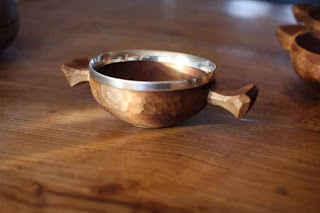
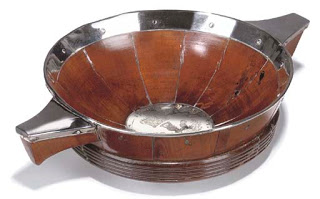
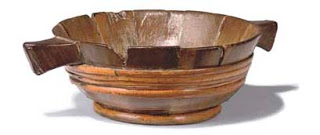
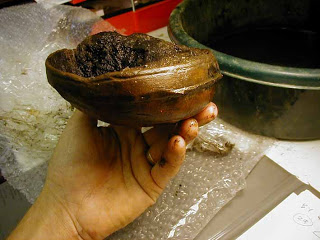

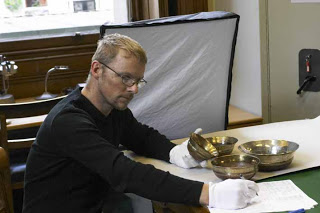
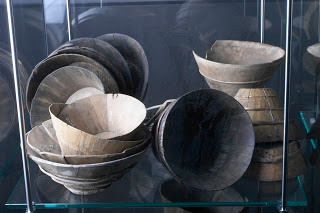







used for a welcome/farewell drink-a wee "deoch an doruis"
For the sassenachs of us a deoch an dorus is a drink at the door. (And also a good young ceilidh band from Glasgow).I guess the four handled ones would be good for sharing as two people would be able to hold the quaich together as it passed.
The only time I have ever heard the quaich mispronounced "quake" is by non-Scots. The scots velar 'ch' should be used in the pronunciation, as in loch or mochy.
At the Gal Gael Trust I've had one of our wood turners turn us a beautiful sycamore quaich. It's used every time we launch a boat, the quaich is charged and passed round. The last dram goes on the boat and then we launch her. Somewhere i read of this being an old scottish tradition and i really wish i could remember where. But it certainly feels right.
Ben I love the work you do at Gal Gael. I suspect your tradition is a new one rather than old but no less valuable for that. Gail McGarva has created some wonderful new traditions with the launches of her "daughter ships".
Robin. You may well be right, one day maybe i'll remember where i read about it and i'll pass it on. As an aside, I only just found your blog tonight and really wish i'd found it years ago. I love a lot of what you write about, and how you write it. Keep up the great work.
This comment has been removed by the author.
The notion of 'communal drinking' a la the quaich is still alive and well in the more rural parts of Crete – I have been present at a party/feast at which the host went round the table with a single glass filling it at each person, who then drained it, and so on. Interestingly, the idea of the communal vessel vs the individual vessel has been explored archaeologically on Crete, where there is the emergence of (smaller) individual vessels in the Middle Bronze Age, compared to those larger vessels of the Early Bronze Age.
I recently used a hand carved silver birch quaich in offering up a libation to the prototype neolithic roundhouse we had just completed. All agreed it was a lovely way of completing the project and the damson gin went down a treat.
I recently acquired a beautiful old wooden turned Quaich with a silver (no mark) top. There is a deer with antlers embossed on one side and the word ‘Seaport’ on the other. I was told this was of the MacKenzie Clan. Any information would be greatly appreciated. Thank you for all you do for Scottish heritage.